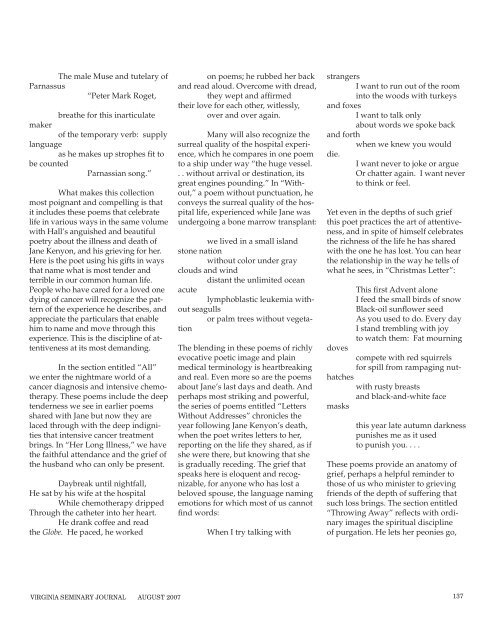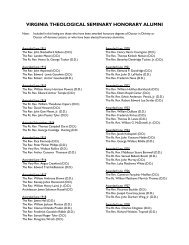Seminary Journal 2008 (August) - Virginia Theological Seminary
Seminary Journal 2008 (August) - Virginia Theological Seminary
Seminary Journal 2008 (August) - Virginia Theological Seminary
You also want an ePaper? Increase the reach of your titles
YUMPU automatically turns print PDFs into web optimized ePapers that Google loves.
The male Muse and tutelary of<br />
Parnassus<br />
“Peter Mark Roget,<br />
breathe for this inarticulate<br />
maker<br />
of the temporary verb: supply<br />
language<br />
as he makes up strophes fi t to<br />
be counted<br />
Parnassian song.”<br />
What makes this collection<br />
most poignant and compelling is that<br />
it includes these poems that celebrate<br />
life in various ways in the same volume<br />
with Hall’s anguished and beautiful<br />
poetry about the illness and death of<br />
Jane Kenyon, and his grieving for her.<br />
Here is the poet using his gifts in ways<br />
that name what is most tender and<br />
terrible in our common human life.<br />
People who have cared for a loved one<br />
dying of cancer will recognize the pattern<br />
of the experience he describes, and<br />
appreciate the particulars that enable<br />
him to name and move through this<br />
experience. This is the discipline of attentiveness<br />
at its most demanding.<br />
In the section entitled “All”<br />
we enter the nightmare world of a<br />
cancer diagnosis and intensive chemotherapy.<br />
These poems include the deep<br />
tenderness we see in earlier poems<br />
shared with Jane but now they are<br />
laced through with the deep indignities<br />
that intensive cancer treatment<br />
brings. In “Her Long Illness,” we have<br />
the faithful attendance and the grief of<br />
the husband who can only be present.<br />
Daybreak until nightfall,<br />
He sat by his wife at the hospital<br />
While chemotherapy dripped<br />
Through the catheter into her heart.<br />
He drank coffee and read<br />
the Globe. He paced, he worked<br />
VIRGINIA SEMINARY JOURNAL AUGUST 2007<br />
on poems; he rubbed her back<br />
and read aloud. Overcome with dread,<br />
they wept and affi rmed<br />
their love for each other, witlessly,<br />
over and over again.<br />
Many will also recognize the<br />
surreal quality of the hospital experience,<br />
which he compares in one poem<br />
to a ship under way “the huge vessel.<br />
. . without arrival or destination, its<br />
great engines pounding.” In “Without,”<br />
a poem without punctuation, he<br />
conveys the surreal quality of the hospital<br />
life, experienced while Jane was<br />
undergoing a bone marrow transplant:<br />
we lived in a small island<br />
stone nation<br />
without color under gray<br />
clouds and wind<br />
distant the unlimited ocean<br />
acute<br />
lymphoblastic leukemia without<br />
seagulls<br />
or palm trees without vegetation<br />
The blending in these poems of richly<br />
evocative poetic image and plain<br />
medical terminology is heartbreaking<br />
and real. Even more so are the poems<br />
about Jane’s last days and death. And<br />
perhaps most striking and powerful,<br />
the series of poems entitled “Letters<br />
Without Addresses” chronicles the<br />
year following Jane Kenyon’s death,<br />
when the poet writes letters to her,<br />
reporting on the life they shared, as if<br />
she were there, but knowing that she<br />
is gradually receding. The grief that<br />
speaks here is eloquent and recognizable,<br />
for anyone who has lost a<br />
beloved spouse, the language naming<br />
emotions for which most of us cannot<br />
fi nd words:<br />
When I try talking with<br />
strangers<br />
I want to run out of the room<br />
into the woods with turkeys<br />
and foxes<br />
I want to talk only<br />
about words we spoke back<br />
and forth<br />
when we knew you would<br />
die.<br />
I want never to joke or argue<br />
Or chatter again. I want never<br />
to think or feel.<br />
Yet even in the depths of such grief<br />
this poet practices the art of attentiveness,<br />
and in spite of himself celebrates<br />
the richness of the life he has shared<br />
with the one he has lost. You can hear<br />
the relationship in the way he tells of<br />
what he sees, in “Christmas Letter”:<br />
doves<br />
This fi rst Advent alone<br />
I feed the small birds of snow<br />
Black-oil sunfl ower seed<br />
As you used to do. Every day<br />
I stand trembling with joy<br />
to watch them: Fat mourning<br />
compete with red squirrels<br />
for spill from rampaging nuthatches<br />
with rusty breasts<br />
and black-and-white face<br />
masks<br />
this year late autumn darkness<br />
punishes me as it used<br />
to punish you. . . .<br />
These poems provide an anatomy of<br />
grief, perhaps a helpful reminder to<br />
those of us who minister to grieving<br />
friends of the depth of suffering that<br />
such loss brings. The section entitled<br />
“Throwing Away” refl ects with ordinary<br />
images the spiritual discipline<br />
of purgation. He lets her peonies go,<br />
137



